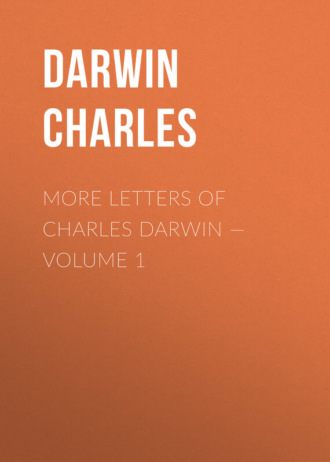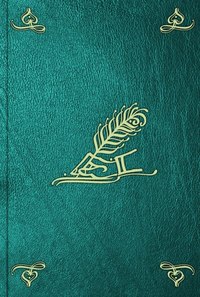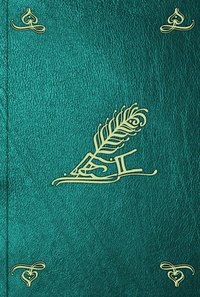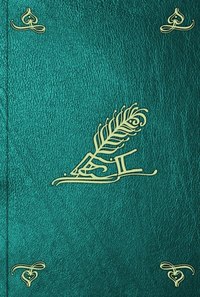 полная версия
полная версияMore Letters of Charles Darwin — Volume 1
LETTER 365. TO J.D. HOOKER. Down, July 30th {1866}.
Many thanks about the lupin. Your letter has interested me extremely, and reminds me of old times. I suppose, by your writing, you would like to hear my notions. I cannot admit the Atlantis connecting Madeira and Canary Islands without the strongest evidence, and all on that side (365/1. Sir J.D. Hooker lectured on "Insular Floras" at the Nottingham meeting of the British Association on August 27th, 1866. His lecture is given in the "Gardeners' Chronicle," 1867, page 6. No doubt he was at this time preparing his remarks on continental extension, which take the form of a judicial statement, giving the arguments and difficulties on both sides. He sums up against continental extension, which, he says, accounts for everything and explains nothing; "whilst the hypothesis of trans-oceanic migration, though it leaves a multitude of facts unexplained, offers a rational solution of many of the most puzzling phenomena." In his lecture, Sir Joseph wrote that in ascending the mountains in Madeira there is but little replacement of lowland species by those of a higher northern latitude. "Plants become fewer and fewer as we ascend, and their places are not taken by boreal ones, or by but very few."): the depth is so great; there is nothing geologically in the islands favouring the belief; there are no endemic mammals or batrachians. Did not Bunbury show that some Orders of plants were singularly deficient? But I rely chiefly on the large amount of specific distinction in the insects and land-shells of P. Santo and Madeira: surely Canary and Madeira could not have been connected, if Madeira and P. Santo had long been distinct. If you admit Atlantis, I think you are bound to admit or explain the difficulties.
With respect to cold temperate plants in Madeira, I, of course, know not enough to form an opinion; but, admitting Atlantis, I can see their rarity is a great difficulty; otherwise, seeing that the latitude is only a little north of the Persian Gulf, and seeing the long sea-transport for seeds, the rarity of northern plants does not seem to me difficult. The immigration may have been from a southerly direction, and it seems that some few African as well as coldish plants are common to the mountains to the south.
Believing in occasional transport, I cannot feel so much surprise at there being a good deal in common to Madeira and Canary, these being the nearest points of land to each other. It is quite new and very interesting to me what you say about the endemic plants being in so large a proportion rare species. From the greater size of the workshop (i.e., greater competition and greater number of individuals, etc.) I should expect that continental forms, as they are occasionally introduced, would always tend to beat the insular forms; and, as in every area, there will always be many forms more or less rare tending towards extinction, I should certainly have expected that in islands a large proportion of the rarer forms would have been insular in their origin. The longer the time any form has existed in an island into which continental forms are occasionally introduced, by so much the chances will be in favour of its being peculiar or abnormal in nature, and at the same time scanty in numbers. The duration of its existence will also have formerly given it the best chance, when it was not so rare, of being widely distributed to adjoining archipelagoes. Here is a wriggle: the older a form is, the better the chance will be of its having become developed into a tree! An island from being surrounded by the sea will prevent free immigration and competition, hence a greater number of ancient forms will survive on an island than on the nearest continent whence the island was stocked; and I have always looked at Clethra (365/2. Clethra is an American shrubby genus of Ericaceae, found nowhere nearer to Madeira than North America. Of this plant and of Persea, Sir Charles Lyell ("Principles," 1872, Volume II., page 422) says: "Regarded as relics of a Miocene flora, they are just such forms as we should naturally expect to have come from the adjoining Miocene continent." See also "Origin of Species," Edition VI., page 83, where a similar view is quoted from Heer.) and the other extra-European forms as remnants of the Tertiary flora which formerly inhabited Europe. This preservation of ancient forms in islands appears to me like the preservation of ganoid fishes in our present freshwaters. You speak of no northern plants on mountains south of the Pyrenees: does my memory quite deceive me that Boissier published a long list from the mountains in Southern Spain? I have not seen Wollaston's, "Catalogue," (365/4. Probably the "Catalogue of the Coleopterous Insects of the Canaries in the British Museum," 1864.) but must buy it, if it gives the facts about rare plants which you mention.
And now I have given more than enough of my notions, which I well know will be in flat contradiction with all yours.
Wollaston, in his "Insecta Maderensia" (365/5. "Insecta Maderensia," London, 1854.), 4to, page 12, and in his "Variation of Species," pages 82-7, gives the case of apterous insects, but I remember I worked out some additional details.
I think he gives in these same works the proportion of European insects.
LETTER 366. TO J.D. HOOKER.
(366/1. Sir Joseph had asked (July 31st, 1866): "Is there an evidence that the south of England and of Ireland were not submerged during the Glacial epoch, when the W. and N. of England were islands in a glacial sea? And supposing they were above water, could the present Atlantic and N.W. of France floras we now find there have been there during the Glacial epoch? — Yet this is what Forbes demands, page 346. At page 347 he sees this objection, and wriggles out of his difficulty by putting the date of the Channel 'towards the close of the Glacial epoch.' What does Austen make the date of the Channel? — ante or post Glacial?" The changes in level and other questions are dealt with in a paper by R.A.C. Austen (afterwards Godwin-Austen), "On the Superficial Accumulations of the Coasts of the English Channel and the Changes they indicate." "Quart. Journ. Geol. Soc." VII., 1851, page 118. Obit. notice by Prof. Bonney in the "Proc. Geol. Soc." XLI., page 37, 1885.)
Down, August 3rd {1866}.
I will take your letter seriatim. There is good evidence that S.E. England was dry land during the Glacial period. I forget what Austen says, but Mammals prove, I think, that England has been united to the Continent since the Glacial period. I don't see your difficulty about what I say on the breaking of an isthmus: if Panama was broken through would not the fauna of the Pacific flow into the W. Indies, or vice versa, and destroy a multitude of creatures? Of course I'm no judge, but I thought De Candolle had made out his case about small areas of trees. You will find at page 112, 3rd edition "Origin," a too concise allusion to the Madeira flora being a remnant of the Tertiary European flora. I shall feel deeply interested by reading your botanical difficulties against occasional immigration. The facts you give about certain plants, such as the heaths, are certainly very curious. (366/2. In Hooker's lecture he gives St. Dabeoc's Heath and Calluna vulgaris as the most striking of the few boreal plants in the Azores. Darwin seems to have been impressed by the boreal character of the Azores, thus taking the opposite view to that of Sir Joseph. See Letter 370, note.) I thought the Azores flora was more boreal, but what can you mean by saying that the Azores are nearer to Britain and Newfoundland than to Madeira? — on the globe they are nearly twice as far off. (366/3. See Letter 368.) With respect to sea currents, I formerly made enquiries at Madeira, but cannot now give you the results; but I remember that the facts were different from what is generally stated: I think that a ship wrecked on the Canary Islands was thrown up on the coast of Madeira.
You speak as if only land-shells differed in Madeira and Porto Santo: does my memory deceive me that there is a host of representative insects?
When you exorcise at Nottingham occasional means of transport, be honest, and admit how little is known on the subject. Remember how recently you and others thought that salt water would soon kill seeds. Reflect that there is not a coral islet in the ocean which is not pretty well clothed with plants, and the fewness of the species can hardly with justice be attributed to the arrival of few seeds, for coral islets close to other land support only the same limited vegetation. Remember that no one knew that seeds would remain for many hours in the crops of birds and retain their vitality; that fish eat seeds, and that when the fish are devoured by birds the seeds can germinate, etc. Remember that every year many birds are blown to Madeira and to the Bermudas. Remember that dust is blown 1,000 miles over the Atlantic. Now, bearing all this in mind, would it not be a prodigy if an unstocked island did not in the course of ages receive colonists from coasts whence the currents flow, trees are drifted and birds are driven by gales. The objections to islands being thus stocked are, as far as I understand, that certain species and genera have been more freely introduced, and others less freely than might have been expected. But then the sea kills some sorts of seeds, others are killed by the digestion of birds, and some would be more liable than others to adhere to birds' feet. But we know so very little on these points that it seems to me that we cannot at all tell what forms would probably be introduced and what would not. I do not for a moment pretend that these means of introduction can be proved to have acted; but they seem to me sufficient, with no valid or heavy objections, whilst there are, as it seems to me, the heaviest objections on geological and on geographical distribution grounds (pages 387, 388, "Origin" (366/4. Edition III., or Edition VI., page 323.) to Forbes' enormous continental extensions. But I fear that I shall and have bored you.
LETTER 367. J.D. HOOKER TO CHARLES DARWIN.
(367/1. In a letter of July 31st, Sir J.D. Hooker wrote, "You must not suppose me to be a champion of continental connection, because I am not agreeable to trans-oceanic migration...either hypothesis appears to me well to cover the facts of oceanic floras, but there are grave objections to both, botanical to yours, geological to Forbes'.")
The following interesting letters give some of Sir Joseph's difficulties.)
Kew, August 4th, 1866.
You mention ("Journal") no land-birds, except introduced, upon St. Helena. Beatson (Introduction xvii) mentions one (367/2. Aegialitis sanctae-helenae, a small plover "very closely allied to a species found in South Africa, but presenting certain differences which entitle it to the rank of a peculiar species" (Wallace, "Island Life," page 294). In the earlier editions of the "Origin" (e.g. Edition III., page 422) Darwin wrote that "Madeira does not possess one peculiar bird." In Edition IV., 1866, page 465, the mistake was put right.) "in considerable numbers," resembles sand-lark — is called "wire bird," has long greenish legs like wires, runs fast, eyes large, bill moderately long, is rather shy, does not possess much powers of flight. What was it? I have written to ask Sclater, also about birds of Madeira and Azores. It is a very curious thing that the Azores do not contain the (non-European) American genus Clethra, that is found in Madeira and Canaries, and that the Azores contain no trace of American element (beyond what is common to Madeira), except a species of Sanicula, a genus with hooked bristles to the small seed-vessels. The European Sanicula roams from Norway to Madeira, Canaries, Cape Verde, Cameroons, Cape of Good Hope, and from Britain to Japan, and also is, I think, in N. America; but does not occur in the Azores, where it is replaced by one that is of a decidedly American type.
This tells heavily against the doctrine that joins Atlantis to America, and is much against your trans-oceanic migration — for considering how near the Azores are to America, and in the influence of the Gulf-stream and prevalent winds, it certainly appears marvellous. Not only are the Azores in a current that sweeps the coast of U. States, but they are in the S.W. winds, and in the eye of the S.W. hurricanes!
I suppose you will answer that the European forms are prepotent, but this is riding prepotency to death.
R.T. Lowe has written me a capital letter on the Madeiran, Canarian, and Cape Verde floras.
I misled you if I gave you to understand that Wollaston's Catalogue said anything about rare plants. I am worked and worried to death with this lecture: and curse myself as a soft headed and hearted imbecile to have accepted it.
LETTER 368. J.D. HOOKER TO CHARLES DARWIN. Kew, Monday {August 6th, 1866}.
Again thanks for your letter. You need not fear my not doing justice to your objections to the continental hypothesis!
Referring to page 344 again (368/1. "Origin of Species," Edition III., pages 343-4: "In some cases, however, as by the breaking of an isthmus and the consequent irruption of a multitude of new inhabitants, or by the final subsidence of an island, the extinction may have been comparatively rapid."), it never occurred to me that you alluded to extinction of marine life: an isthmus is a piece of land, and you go on in the same sentence about "an island," which quite threw me out, for the destruction of an isthmus makes an island!
I surely did not say Azores nearer to Britain and Newfoundland "than to Madeira," but "than Madeira is to said places."
With regard to the Madeiran coleoptera I rely very little on local distribution of insects — they are so local themselves. A butterfly is a great rarity in Kew, even a white, though we are surrounded by market gardens. All insects are most rare with us, even the kinds that abound on the opposite side of Thames.
So with shells, we have literally none — not a Helix even, though they abound in the lanes 200 yards off the Gardens. Of the 89 Dezertas insects {only?} 11 are peculiar. Of the 162 Porto Santan 113 are Madeiran and 51 Dezertan.
Never mind bothering Murray about the new edition of the "Origin" for me. You will tell me anything bearing on my subject.
LETTER 369. J.D. HOOKER TO CHARLES DARWIN. Kew, August 7th, 1866.
Dear old Darwin,
You must not let me worry you. I am an obstinate pig, but you must not be miserable at my looking at the same thing in a different light from you. I must get to the bottom of this question, and that is all I can do. Some cleverer fellow one day will knock the bottom out of it, and see his way to explain what to a botanist without a theory to support must be very great difficulties. True enough, all may be explained, as you reason it will be — I quite grant this; but meanwhile all is not so explained, and I cannot accept a hypothesis that leaves so many facts unaccounted for. You say the temperate parts of N. America {are} nearly two and a half times as distant from the Azores as Europe is. According to a rough calculation on Col. James' chart I make E. Azores to Portugal 850, West do. to Newfoundland 1500, but I am writing to a friend at Admiralty to have the distance calculated (which looks like cracking nuts with Nasmyth's hammer!)
Are European birds blown to America? Are the Azorean erratics an established fact? I want them very badly, though they are not of much consequence, as a slight sinking would hide all evidence of that sort.
I do want to sum up impartially, leaving the verdict to jury. I cannot do this without putting all difficulties most clearly. How do you know how you would fare with me if you were a continentalist! Then too we must recollect that I have to meet a host who are all on the continental side — in fact, pretty nearly all the thinkers, Forbes, Hartung, Heer, Unger, Wollaston, Lowe (Wallace, I suppose), and now Andrew Murray. I do not regard all these, and snap my fingers at all but you; in my inmost soul I conscientiously say I incline to your theory, but I cannot accept it as an established truth or unexceptionable hypothesis.
The "Wire bird" being a Grallator is a curious fact favourable to you...How I do yearn to go out again to St. Helena.
Of course I accept the ornithological evidence as tremendously strong, though why they should get blown westerly, and not change specifically, as insects, shells, and plants have done, is a mystery.
LETTER 370. TO J.D. HOOKER. Down, August 8th {1866}.
It would be a very great pleasure to me if I could think that my letters were of the least use to you. I must have expressed myself badly for you to suppose that I look at islands being stocked by occasional transport as a well-established hypothesis. We both give up creation, and therefore have to account for the inhabitants of islands either by continental extensions or by occasional transport. Now, all that I maintain is that of these two alternatives, one of which must be admitted, notwithstanding very many difficulties, occasional transport is by far the most probable. I go thus far further — that I maintain, knowing what we do, that it would be inexplicable if unstocked islands were not stocked to a certain extent at least by these occasional means. European birds are occasionally driven to America, but far more rarely than in the reverse direction: they arrive via Greenland (Baird); yet a European lark has been caught in Bermuda.
By the way, you might like to hear that European birds regularly migrate via the northern islands to Greenland.
About the erratics in the Azores see "Origin," page 393. (370/1. "Origin," Edition VI., page 328. The importance of erratic blocks on the Azores is in showing the probability of ice-borne seeds having stocked the islands, and thus accounting for the number of European species and their unexpectedly northern character. Darwin's delight in the verification of his theory is described in a letter to Sir Joseph of April 26th, 1858, in the "Life and Letters," II., page 112.) Hartung could hardly be mistaken about granite blocks on a volcanic island.
I do not think it a mystery that birds have not been modified in Madeira. (370/2. "Origin," Edition VI., page 328. Madeira has only one endemic bird. Darwin accounts for the fact from the island having been stocked with birds which had struggled together and become mutually co-adapted on the neighbouring continents. "Hence, when settled in their new homes, each kind will have been kept by the others in its proper place and habits, and will consequently have been but little liable to modification." Crossing with frequently arriving immigrants will also tend to keep down modification.) Pray look at page 422 of "Origin" {Edition III.}. You would not think it a mystery if you had seen the long lists which I have (somewhere) of the birds annually blown, even in flocks, to Madeira. The crossed stock would be the more vigorous.
Remember if you do not come here before Nottingham, if you do not come afterwards I shall think myself diabolically ill-used.
LETTER 371. J.D. HOOKER TO CHARLES DARWIN. Kew, August 9th, 1866.
If my letters did not gene you it is impossible that you should suppose that yours were of no use to me! I would throw up the whole thing were it not for correspondence with you, which is the only bit of silver in the affair. I do feel it disgusting to have to make a point of a speciality in which I cannot see my way a bit further than I could before I began. To be sure, I have a very much clearer notion of the pros and cons on both sides (though these were rather forgotten facts than rediscoveries). I see the sides of the well further down more distinctly, but the bottom is as obscure as ever.
I think I know the "Origin" by heart in relation to the subject, and it was reading it that suggested the queries about Azores boulders and Madeira birds. The former you and I have talked over, and I thought I remembered that you wanted it confirmed. The latter strikes me thus: why should plants and insects have been so extensively changed and birds not at all? I perfectly understand and feel the force of your argument in reference to birds per se, but why do these not apply to insects and plants? Can you not see that this suggests the conclusion that the plants are derived one way and the birds another?
I certainly did take it for granted that you supposed the stocking {by} occasional transport to be something even more than a "well-established hypothesis," but disputants seldom stop to measure the strength of their antagonist's opinion.
I shall be with you on Saturday week, I hope. I should have come before, but have made so little progress that I could not. I am now at St. Helena, and shall then go to, and finish with, Kerguelen's land.
(371/1. After giving the distances of the Azores, etc., from America, Sir Joseph continues: — )
But to my mind {it} does not mend the matter — for I do not ask why Azores have even proportionally (to distance) a smaller number of American plants, but why they have none, seeing the winds and currents set that way. The Bermudas are all American in flora, but from what Col. Munro informs me I should say they have nothing but common American weeds and the juniper (cedar). No changed forms, yet they are as far from America as Azores from Europe. I suppose they are modern and out of the pale.
...There is this, to me, astounding difference between certain oceanic islands which were stocked by continental extension and those stocked by immigration (following in both definitions your opinion), that the former {continental} do contain many types of the more distant continent, the latter do not any! Take Madagascar, with its many Asiatic genera unknown in Africa; Ceylon, with many Malayan types not Peninsular; Japan, with many non-Asiatic American types. Baird's fact of Greenland migration I was aware of since I wrote my Arctic paper. I wish I was as satisfied either of continental {extensions} or of transport means as I am of my Greenland hypothesis!
Oh, dear me, what a comfort it is to have a belief (sneer away).
LETTER 372. J.D. HOOKER TO CHARLES DARWIN. Kew, December 4th, 1866.
I have just finished the New Zealand "Manual" (372/1. "Handbook of the New Zealand Flora."), and am thinking about a discussion on the geographical distribution, etc., of the plants. There is scarcely a single indigenous annual plant in the group. I wish that I knew more of the past condition of the islands, and whether they have been rising or sinking. There is much that suggests the idea that the islands were once connected during a warmer epoch, were afterwards separated and much reduced in area to what they now are, and lastly have assumed their present size. The remarkable general uniformity of the flora, even of the arboreous flora, throughout so many degrees of latitude, is a very remarkable feature, as is the representation of a good many of the southern half of certain species of the north, by very closely allied varieties or species; and, lastly, there is the immense preponderance of certain genera whose species all run into one another and vary horribly, and which suggest a rising area. I hear that a whale has been found some miles inland.
LETTER 373. J.D. HOOKER TO CHARLES DARWIN. Kew, December 14th, 1866.
I do not see how the mountains of New Zealand, S. Australia, and Tasmania could have been peopled, and {with} so large an extent of antarctic (373/1. "Introductory Essay to Flora of New Zealand," page xx. "The plants of the Antarctic islands, which are equally natives of New Zealand, Tasmania, and Australia, are almost invariably found only on the lofty mountains of these countries.") forms common to Fuegia, without some intercommunication. And I have always supposed this was before the immigration of Asiatic plants into Australia, and of which plants the temperate and tropical plants of that country may be considered as altered forms. The presence of so many of these temperate and cold Australian and New Zealand genera on the top of Kini Balu in Borneo (under the equator) is an awful staggerer, and demands a very extended northern distribution of Australian temperate forms. It is a frightful assumption that the plains of Borneo were covered with a temperate cold vegetation that was driven up Kini Balu by the returning cold. Then there is the very distant distribution of a few Australian types northward to the Philippines, China, and Japan: that is a fearful and wonderful fact, though, as these plants are New Zealand too for the most part, the migration northward may have been east of Australia.









